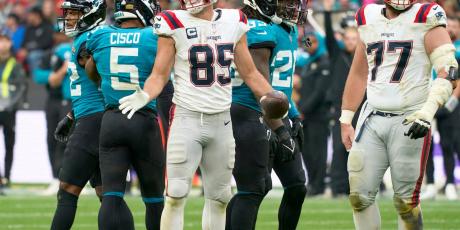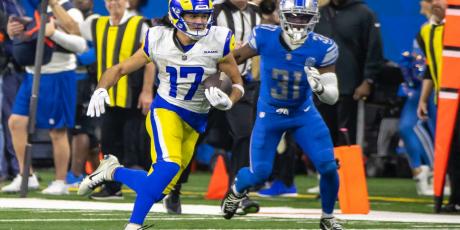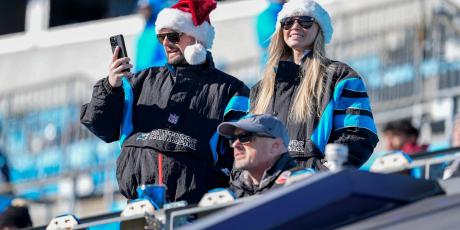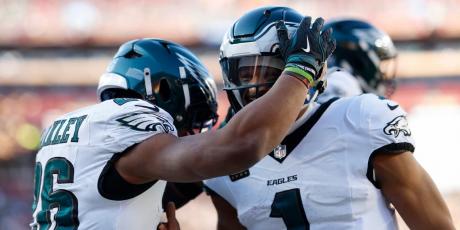Mike Williams, Corey Davis & the 2017 Rookie Wide Receivers

Our four-part series on the 2017 draft class concludes with a look at the wide receiver position, which most analysts consider among the weakest in years. With a dominant group of running backs taking center stage, the wideouts are actually being overshadowed, which has not happened for a while in most dynasty leagues.
Editor's Note: Enter to win a free Dynasty League Football subscription (a $29 value)! You must be a 4for4 subscriber to enter to win!
Tier One
The top tier of wide receivers is shallow, which is a large part of the reason this group is being labeled as subpar in comparison to past wide receiver draft classes.
Corey Davis, Western Michigan
Unfortunately, we haven’t seen much from MAC superstar Davis lately after he suffered an ankle injury that required surgery early in the offseason. That bum ankle caused him to miss the Combine as well as his Pro Day, and if recent reports are to be believed, it could cause him to fall out of the first round. On top of the injury, some analysts are seemingly worried about Davis’ lack of top-flight competition, although he did step up his game when he played against Michigan State and other Power Five schools.
Davis put enough on tape over the past four years at Western Michigan that few should doubt his talents. He surprisingly opted to stay in school following his junior year and finished his career as the all-time Division I receiving yardage leader with 5,285. Davis is the only player in this class viewed as a potential number-one wideout. His numbers support this -- he had a breakout age of 18.7, among the youngest in this class, according to PlayerProfiler.com. He also accounted for over 35% of his team’s targets, receptions, and receiving yardage. Davis did have some issues with dropped passes, but the good far outweighs the bad.
Davis may have emerged as the pre-draft favorite to be the top rookie off the board in dynasty drafts. His latest dynasty average draft position (ADP) from Dynasty League Football shows he is being drafted as the WR18 with an overall ADP of 27.8, making him the second rookie selected behind running back Leonard Fournette. Like all of these rookies, this weekend’s events will go a long way towards determining their keeper and dynasty value.
Mike Williams, Clemson
At 6’4” and 218 pounds, there is no question Williams has the frame to play physical, but somehow, he actually plays even bigger than his frame suggests. Williams lacks the top-end speed of other receivers in the '17 class, but he was still a dominant downfield target. He hauled in over 51% of his deep targets, which was good for a ranking of sixth in the nation. Williams’ size also gives him a huge catch radius and he has become well-known for high-pointing the football. There are few negatives in Williams’ game, but one that stands out is he struggles to create separation in his routes.
A serious neck injury in the 2015 season opener cost Williams the remainder of the year and threatened his career at the time. However, he made an impressive return to the field in 2016 and helped lead Clemson to a National Championship win over Alabama.
While Davis' fantasy stock has been ascending, Williams’ has been dropping, despite the likelihood that he, not Davis, will be the first wideout drafted Thursday night. Williams is currently the WR25 with an overall ADP of 43.3. He’s the fifth rookie drafted behind Davis, Fournette, Dalvin Cook and Christian McCaffrey.
Tier Two
It is difficult to create tiers with this wide receiver class, which is no surprise given that there is little consensus among analysts and fantasy players alike on how they should be valued. I’ll continue do my best to sort it out.
John Ross, Washington
The new record holder in the 40-yard dash at the Combine, Ross’ speed can’t be denied. That speed -- which was constantly on display each weekend of the 2016 season -- along with his small frame cause him to project as a slot receiver in the NFL, but he lined up all over the field for the Huskies on his way to staggering final season production (81 receptions, 1,150 yards, 17 TDs). Ross’ Combine performance sits in the 95th percentile for speed score, 87th percentile for burst score, and 97th percentile for broad jump -- none of these should be surprising for those who saw him play last season.
Unfortunately, Ross, who at times played defensive back for the Huskies, had serious injury issues including a torn ACL and MCL in 2015, as well as a recent shoulder surgery following the NFL Combine. This injury history, along with his diminutive size, may be enough to hurt Ross’ dynasty value.
Currently, Ross is among a deep group of players challenging to crack the top six rookies, but he could be the favorite to do just that. Currently, Ross is the eighth rookie drafted with an overall ADP of 76, making him the overall WR43. Ross still has a chance to be the first wide receiver drafted, and just as we saw speedster Will Fuller gain value after being drafted last year in the first round, the same could happen for Ross.
Juju Smith-Schuster, Southern California
Early in his college career, it appeared as if Smith-Schuster would easily be the top wide receiver prospect in this class, but a disappointing junior season and a dose of reality have pushed him down the board. He’s now viewed as a Day Two prospect, but that doesn’t mean he can’t still be a prime target for fantasy owners.
Smith-Schuster’s breakout age of 18.9 and dominant first two seasons against Pac-12 competition are encouraging. He’s still a young prospect -- the youngest in the entire draft class -- and won’t turn 21 until November. He routinely displayed impressive ball skills, though he lacks explosiveness and could stand to improve his route running.
Smith-Schuster also has a chance to top the second tier of rookie prospects in dynasty and keeper leagues, but needs an ideal landing spot to leapfrog the other candidates. He currently sports an overall ADP of 73.7, good for WR40, the seventh rookie drafted. With Smith-Schuster expected to be drafted in the second round of the NFL Draft at the earliest, I expect him to fall from his current ADP in upcoming fantasy drafts.
Curtis Samuel, Ohio State
Samuel is one of the most versatile -- and in some ways, one of the most confusing -- prospects in this class. The running ba...er, wide receiver from Ohio State played all over the field. He carried the ball, lined up in the slot, and made an impact on special teams. His versatility even garnered him some momentary Day-One buzz.
Few seem to doubt the usefulness of Samuel on his eventual NFL team, but there is some doubt as to what type of fantasy asset he can be, as versatility could end up causing him to be a highly inconsistent weekly producer. That being said, Samuel is being underrated in current dynasty startups with an overall ADP of 126.5, which places him as just the 17th rookie selected.
Chris Godwin, Penn State
Godwin is one of many players to experience a steady rise in dynasty value since the college season concluded. He is an aggressive receiver who is at his best when attempting a contested catch. His Combine performance was impressive: a speed score in the 89th percentile and a SPARQ score in the 95th percentile, ninth overall in this year's receiver class.
Godwin needs to improve his route running in order to make a successful transition to the NFL. He also needs to improve his production after the catch, where his struggles are surprising given his impressive 40 time of 4.42 seconds.
Godwin is another player on the late first round/early second round borderline, currently going as the fifteenth rookie drafted with an overall ADP of 116.5. This also makes Godwin the WR58, just behind reliable veteran Larry Fitzgerald.
Zay Jones, East Carolina
One of the hottest names of the past couple of months has been Jones, who saw a monstrous volume during his time at East Carolina, especially in his 158-reception, 1,746-yard final season. However, he averaged just over 11 yards per reception, which is among the lowest in the class. Jones did most of his work in the intermediate area, offering his quarterback a reliable target on the majority of passing plays.
Jones lined up all over the field and that resulted in better than a 40% market share of targets, receptions, and receiving yards for East Carolina. He leaves school as the all-time FBS leader in receptions with 399.
Jones’ current dynasty value is similar to that of Godwin and Samuel. Jones' ADP of 136.5 is good for the WR69 and the eighteenth rookie spot. Also like Samuel and Godwin, Jones' value could be greatly impacted by being selected on the Draft’s second day.
4for4's John Paulsen will be doing a live breakdown of the NFL Draft. Follow along here!
Tier Three
Again, it is a difficult task to sort these players into tiers. It could be argued that one or more of the tier three group actually belongs in tier two.
Carlos Henderson, Louisiana Tech
Henderson was a huge playmaker for Louisiana Tech, combining with Trent Taylor to form the most productive wideout duo in college football last season. Henderson is an electric playmaker, vertical threat, and all-around weapon. He led the FBS in all-purpose yardage with 2,473 and averaged over 18 yards per reception. He’s not easy to bring down and led the nation with 48 forced missed tackles.
Surprisingly, Henderson’s Combine performance resulted in low numbers for agility (13th percentile) and three-cone (11th percentile), though his burst score was in the 80th percentile.
Looking at dynasty ADP once again, Henderson is stuck in the rookie third tier. He's being drafted as the 16th rookie with an overall ADP of 124.5. This makes him an attractive option at the WR62 spot, just ahead of Samuel.
Taywan Taylor, Western Kentucky
Taylor, a strong route runner, quietly dominated the Combine, posting scores good enough for a 92nd percentile Agility Score, a 96th-percentile three-cone, and a 96th-percentile broad jump. Taylor was putting up impressive numbers way before February though. He was the key option in the Hilltopper passing game, averaging 17.8 yards per reception, 7.7 yards after the catch, and according to PFF, 3.92 yards per route run, second in the class.
Detractors have said Taylor’s gaudy numbers are simply a result of the up-tempo WKU offense and a schedule filled mostly with inferior competition. There are also some concerns about Taylor’s size, but he seems to play bigger than his 5’11”, 203-pound frame would suggest.
Taylor is a huge value in startup dynasty drafts, being selected with an ADP of 180.2, the 82nd wide receiver and 26th rookie, suggesting he'll be an option in the late second or early third round of upcoming rookie drafts, which looks like a value.
Cooper Kupp, Eastern Washington
It is difficult to know what to expect from Kupp, a dominant small-school star. Kupp began his career as a walk-on and finished as a record-breaker. Kupp has strong hands and attacks the football on every play, sporting ideal size (6’2”, 204 pounds) for a receiver. He’s also an exceptional route runner. Most of Kupp’s damage was done from the slot, where he finished with 88 receptions, third most among the class.
At nearly 24 years old, Kupp is on the older side for an incoming NFL rookie. For reference, he's older than class of 2014 wideouts like Brandin Cooks, Mike Evans and Allen Robinson, among others. Of course, there are also questions about how Kupp can transition from a low level of college football to playing on Sundays.
Isaiah Ford, Virginia Tech
Ford is another receiver who enjoyed early success in his college career, with a breakout age of 18.6. He was a key cog in the Hokies offense throughout his career and displayed explosive leaping ability to high-point the ball and make tough catches.
However, Ford needs to add muscle, as he was often bumped off his routes. Surprisingly, he also struggled to produce after the catch. He has the looks of an inconsistent weapon in an NFL offense.
K.D. Cannon, Baylor
If you’ve seen Baylor play over the years, you likely already know what you’re getting from Cannon. Like many before him, he’s an undersized, speedy receiver who can make a huge play downfield at any time. His 40-yard time of 4.41 placed him in the 91st percentile, while he also had an early breakout age (18.8). However, he must improve his route running and eliminate the focus drops he had during his Bears career.
Ishmael Zamora, Baylor
Cannon’s teammate, Zamora, has become a hotly contested prospect in recent weeks. Zamora did not receive an invite to the Combine due to a previous incident in which he released a video of himself abusing a dog. This also resulted in a brief suspension.
With Baylor spreading the ball around and the entire athletic program in turmoil, Zamora’s final season numbers (63 receptions, 809 yards, 8 TDs) look meager, but he has ideal size (90th-percentile catch radius) and speed (85th-percentile speed score), which could translate to massive upside.
Malachi Dupre, LSU
Entering college as one of the top wide receiver recruits in the nation, expectations for Dupre in the Tigers’ offense were sky-high. After one season, it appeared he would live up to the hype, but unfortunately, the offense struggled and the program went through a coaching change over the next two seasons. Dupre’s production ended up shockingly low, and while part of that can be attributed to a run-first offense and subpar quarterback play, much of it is on Dupre himself.
Nevertheless, Dupre is still viewed as a strong athlete. A former track star, he finished the Combine with a 98th-percentile broad jump and 90th-percentile vertical. Because of his ideal size, some NFL team will take a shot on him on Day Two or early on Day Three. Fantasy players should consider him a late-round flier until further notice.
Dede Westbrook, Oklahoma
A Heisman finalist in his senior year for Oklahoma, Westbrook was an electric playmaker for the Sooners, routinely displaying blazing speed. He didn’t make all of his plays by running away from defenders, though -- he also forced 20 missed tackles and averaged nearly 10 yards after each catch.
Unfortunately for Westbrook, the negatives have been piling up lately. At 23 years old, there is concern about how much room there is for improvement. There's also the issue of his 178-pound frame. His size and style of play have led to multiple injuries throughout his collegiate career. Factor in some off-the-field issues that have come to light since the conclusion of the college season and a 105.1 SPARQ score, which places Westbrook well outside of the top 100 receivers in this class, and he looks like a late-round prospect in both the NFL Draft and fantasy leagues. Currently, Westbrook is the 28th rookie drafted in startup dynasty leagues with an overall ADP of 184.7. If the reports are true and he falls to the third day of the draft, those rankings are unlikely to improve.
Tier Four
There are still other wideouts to keep in mind, especially as you reach the third round and beyond of your dynasty rookie drafts. Among the players to consider are: Chad Hansen (California), ArDarius Stewart (Alabama), Josh Malone (Tennessee), Josh Reynolds (Texas A&M), Amara Darboh (Michigan), Mack Hollins and Ryan Switzer (North Carolina).
Editor's Note: 4for4's popular DFS Subscription will be making major upgrades for 2017! Subscribe now and get an an early-bird discount!
Related Articles
- 2017 NFL Draft: Live Fantasy Recap (Round 1)
- The Deep Rookie RB Class of '17: Leonard Fournette, Dalvin Cook & How Should we Value Joe Mixon?
- OJ Howard, Evan Engram and the Rookie Tight End Depth of 2017
- Mitchell Trubisky, DeShaun Watson and 4 Other Rookie QBs You Should Know About
- Just a Friendly Reminder That Martavis Bryant is Really Good
- Will Terrelle Pryor Thrive in Washington?
- How Will DeSean Jackson Impact the Buccaneers Offense?
- Are the Eagles Ready to Soar with Alshon Jeffery and Torrey Smith?
- Is Brandon Marshall Done?
- Optimal MFL10 Roster Construction: Part 2
- Terrelle Pryor, Rex Burkhead and 15 Other Free Agency Winners & Losers
- 2017 Early Rankings: Wide Receivers
Listen to the Most Accurate big Free Agency Pod with John Paulsen:






















